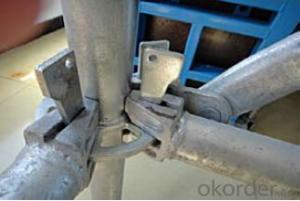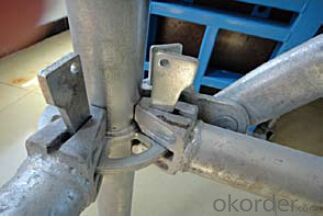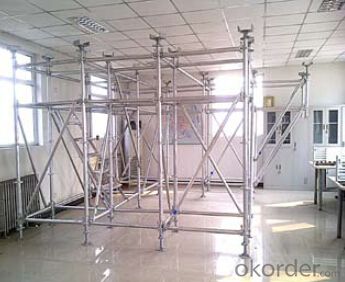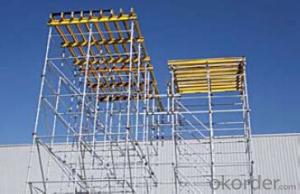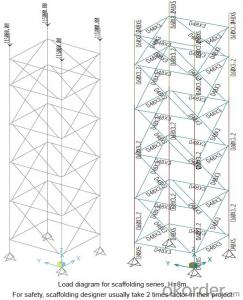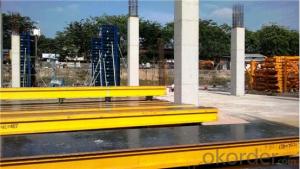Ring-lock Scaffolding Accessories for formwork and scaffolding system
- Loading Port:
- Tianjin
- Payment Terms:
- TT OR LC
- Min Order Qty:
- 50 m²
- Supply Capability:
- 1000 m²/month
OKorder Service Pledge
Quality Product, Order Online Tracking, Timely Delivery
OKorder Financial Service
Credit Rating, Credit Services, Credit Purchasing
You Might Also Like
Ring-lock Scaffolding
A support system for construction, ownsadvantages of both cup-lock scaffolding andshoring tower.
It is in the development direction of new typescaffolding.
It is widely used in buildings, bridges, tunnels etc..
Characteristics:
◆ Easy to storage and transportation
◆ High degree of standardization
◆ Easy and quick erection
◆ Excellent stability and bearing capacity
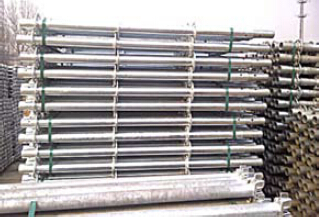

- Q: How does steel formwork handle formwork stripping and cleaning?
- Steel formwork is known for its durability and strength, making it highly suitable for handling formwork stripping and cleaning processes. When it comes to formwork stripping, steel formwork can easily be disassembled and removed from the concrete structure without causing damage. This is due to the inherent rigidity and stability of steel, which allows for efficient and safe stripping. Moreover, steel formwork is resistant to moisture, chemicals, and other environmental factors, making it easier to clean and maintain. After the formwork is stripped, any concrete residue or debris can be easily removed from the steel surface using appropriate cleaning techniques. This may involve the use of high-pressure water jets, scrubbing, or other cleaning agents, depending on the specific requirements. Steel formwork also offers the advantage of reusability, as it can withstand multiple uses without significant deterioration. Once the formwork is cleaned, it can be inspected for any damages or wear and tear. Any necessary repairs or replacements can be made to ensure the formwork's integrity for future use. In summary, steel formwork handles formwork stripping and cleaning efficiently due to its durability, strength, and resistance to environmental factors. Its easy disassembly, cleaning capabilities, and reusability make it a preferred choice for construction projects where formwork needs to be stripped and maintained regularly.
- Q: What are the considerations when selecting the size and spacing of steel formwork panels?
- When selecting the size and spacing of steel formwork panels, there are several important considerations to take into account. Firstly, the size of the panels should be determined based on the specific requirements of the project. Factors such as the dimensions and shape of the concrete structure being formed, as well as the load-bearing capacity of the panels, need to be considered. It is crucial to choose panel sizes that can adequately support the weight of the concrete and any additional loads during the construction process. The spacing of the steel formwork panels is another important consideration. The spacing should be determined based on the desired concrete thickness and the ability of the panels to resist any deflection or bending under the weight of the concrete. The spacing should be close enough to prevent any excessive sagging or bulging of the panels, which could result in an uneven concrete surface. Additionally, the spacing should also allow for easy installation, removal, and handling of the formwork panels. This is particularly important for efficient and cost-effective construction processes. Adequate spacing between panels will allow for smooth and safe placement and removal of the formwork, reducing the risk of accidents or delays. Furthermore, the spacing should also take into account the size and accessibility requirements for construction equipment and workers. Sufficient space between the panels will allow for the movement and operation of equipment, such as cranes or concrete pumps, and ensure that workers can access the formwork to complete their tasks safely and efficiently. Overall, the size and spacing of steel formwork panels should be carefully considered to ensure the structural integrity of the concrete structure being formed, as well as the safety and efficiency of the construction process. It is important to consult with experienced professionals or engineers to determine the most suitable panel sizes and spacing for each specific project.
- Q: Are there any specific maintenance requirements for steel formwork?
- Steel formwork has specific maintenance requirements that must be followed to ensure its optimal performance and durability. Cleaning the formwork after each use is crucial. This involves thoroughly removing any concrete residue and preventing the accumulation of corrosive agents. A mild detergent and water can be used for cleaning, followed by proper drying of all surfaces. Inspecting the formwork for any signs of damage or wear is also important. This includes checking for cracks, rust, or any other defects that could weaken the structure. Prompt repair or replacement of damaged components is necessary to maintain the formwork's integrity and safety. Proper storage and handling practices are essential for steel formwork maintenance. The formwork should be stored in a dry and well-ventilated area to prevent corrosion. Protection from moisture, extreme temperatures, and direct sunlight is necessary. When handling the formwork, abrasive materials or tools that could cause scratches or dents should be avoided. Regular lubrication of moving parts, such as hinges and locks, is recommended. This ensures smooth operation and prevents seizing or jamming. Using a suitable lubricant reduces friction and extends the life of these components. Lastly, it is advisable to follow the manufacturer's guidelines and recommendations for specific maintenance requirements of the steel formwork. These guidelines may include additional steps or precautions that are specific to the formwork system being used. By adhering to these maintenance requirements, steel formwork can be kept in excellent condition, allowing for efficient and safe construction practices.
- Q: How does steel formwork affect the overall sound insulation of a building?
- The overall sound insulation of a building is not directly affected by steel formwork. The quality and design of the walls, floors, and ceilings are the main factors that determine sound insulation, regardless of the formwork material used. However, sound insulation may be indirectly influenced by steel formwork during the construction phase. Steel formwork is renowned for its rigidity and strength, which ensures precise and accurate pouring of concrete. This precise construction technique helps minimize gaps and imperfections that can occur during the concrete casting process. Consequently, steel formwork contributes to creating a smoother and more uniform concrete surface, reducing the possibility of sound leakage through cracks or joints. Additionally, steel formwork can be employed to create even and smooth surfaces, facilitating the installation of soundproofing materials like acoustic panels or insulation. These supplementary soundproofing measures, when incorporated during construction, can enhance the overall sound insulation of the building. It is important to recognize that although steel formwork can indirectly impact sound insulation during construction, the primary elements affecting sound insulation are the materials and techniques utilized in constructing walls, floors, and ceilings. Architectural design, insulation materials, and sealing techniques all play a crucial role in achieving optimal sound insulation levels.
- Q: Can steel formwork be used for water tanks or swimming pools?
- Steel formwork is a versatile option for constructing water tanks or swimming pools. With its durability and strength, it can withstand the pressure exerted by water, ensuring a stable and leak-free structure. Furthermore, the flexibility of steel formwork allows for easy customization to achieve the desired shape and size. Additionally, its convenient assembly and disassembly make it a convenient choice for construction projects. Nonetheless, it is crucial to properly waterproof and coat the steel formwork to prevent corrosion and maintain the integrity of the water tank or swimming pool.
- Q: Is steel formwork resistant to corrosion?
- Yes, steel formwork is generally resistant to corrosion. Steel, particularly stainless steel, is known for its high resistance to corrosion, making it a suitable choice for construction applications. However, it is important to note that the extent of corrosion resistance can depend on factors such as the grade of steel used, the environment in which the formwork is used, and the presence of any additional protective coatings. Regular maintenance and proper care can also help prolong the lifespan and corrosion resistance of steel formwork.
- Q: How does steel formwork handle formwork stability during concrete pouring?
- Steel formwork provides excellent formwork stability during concrete pouring due to its high strength and rigidity. It can withstand the pressure and weight of the fresh concrete without deformation or collapse, ensuring the desired shape and structure of the concrete elements. Additionally, steel formwork can be easily adjusted and secured in place, allowing for precise alignment and stability during the pouring process.
- Q: How does steel formwork handle different concrete surface treatments?
- Steel formwork is known for its versatility and durability in handling different concrete surface treatments. Due to its strong and rigid structure, steel formwork can effectively withstand the pressure and weight of different concrete surface treatments without deforming or collapsing. Steel formwork is commonly used in construction projects that require various surface treatments, such as smooth, textured, or patterned finishes. The steel panels and frames provide a stable and rigid surface, ensuring that the concrete is poured and cured evenly. This helps to achieve a high-quality and consistent finish. Additionally, steel formwork can easily accommodate different types of surface treatments. For instance, if a project requires a smooth finish, the steel formwork can be polished or coated with a release agent to create a smooth surface. If a project requires a textured or patterned finish, the steel formwork can be specially designed or modified to incorporate the desired texture or pattern. This flexibility allows for creativity and customization in achieving the desired aesthetics. Furthermore, steel formwork can be reused multiple times, making it cost-effective and environmentally friendly. This means that it can handle different concrete surface treatments in various projects, providing consistent and reliable results each time. In summary, steel formwork is an excellent choice for handling different concrete surface treatments due to its strength, durability, and versatility. It can withstand the pressure and weight of various finishes, accommodate different types of surface treatments, and be reused multiple times, making it a reliable and cost-effective option in construction projects.
- Q: Can steel formwork be used for both indoor and outdoor construction projects?
- Steel formwork is suitable for both indoor and outdoor construction projects, providing durability and strength. It can withstand different weather conditions, making it an ideal choice for outdoor projects. This material is highly robust and can support the weight of concrete and other construction materials, ensuring stability. Another advantage of steel formwork is its reusability, making it a cost-effective option for both indoor and outdoor projects. Construction professionals widely prefer its versatility and resilience for various applications.
- Q: What are the common types of form ties used with steel formwork?
- Steel formwork utilizes various types of form ties to hold the formwork together and guarantee the stability and strength of the concrete structure. 1. The most commonly used form ties in steel formwork are snap ties. These ties consist of a metal rod with cones or flat disks on each end. They are inserted through holes in the formwork panels and secured in place using a wedge or pin. Snap ties are popular in formwork construction due to their easy installation and removal. 2. Another type of form tie is the flat tie, which is similar to a snap tie but has a flat plate on one end instead of a cone. The flat plate provides a larger surface area for load distribution, making it suitable for heavy-duty applications. Flat ties are commonly employed in large-scale construction projects that require high strength and stability. 3. Waler ties are used to connect the formwork panels to horizontal beams known as walers, which support the formwork. These ties, usually made of steel bars or rods, are secured to the formwork panels using bolts or clamps. Waler ties distribute the load evenly across the formwork system, providing additional support and stability. 4. Coil ties are flexible ties made of wire coils. They are used to secure opposing formwork panels together. The coil ties are inserted into the formwork panels and twisted at both ends to secure them in place. Coil ties are cost-effective and user-friendly, making them a popular choice for small-scale construction projects. 5. Cone ties resemble snap ties but have a cone-shaped end on one side. This design allows for easy insertion and removal of the tie. Cone ties are typically utilized in situations requiring frequent formwork assembly and disassembly, such as the construction of temporary structures or formwork systems used in precast concrete production. These represent some of the common types of form ties used in conjunction with steel formwork. The selection of a suitable form tie depends on various factors, including the project's size and complexity, the required strength and stability, and the ease of installation and removal. Choosing the appropriate form ties is essential to ensure the safety and efficiency of the formwork system.
Send your message to us
Ring-lock Scaffolding Accessories for formwork and scaffolding system
- Loading Port:
- Tianjin
- Payment Terms:
- TT OR LC
- Min Order Qty:
- 50 m²
- Supply Capability:
- 1000 m²/month
OKorder Service Pledge
Quality Product, Order Online Tracking, Timely Delivery
OKorder Financial Service
Credit Rating, Credit Services, Credit Purchasing
Similar products
Hot products
Hot Searches
Related keywords
